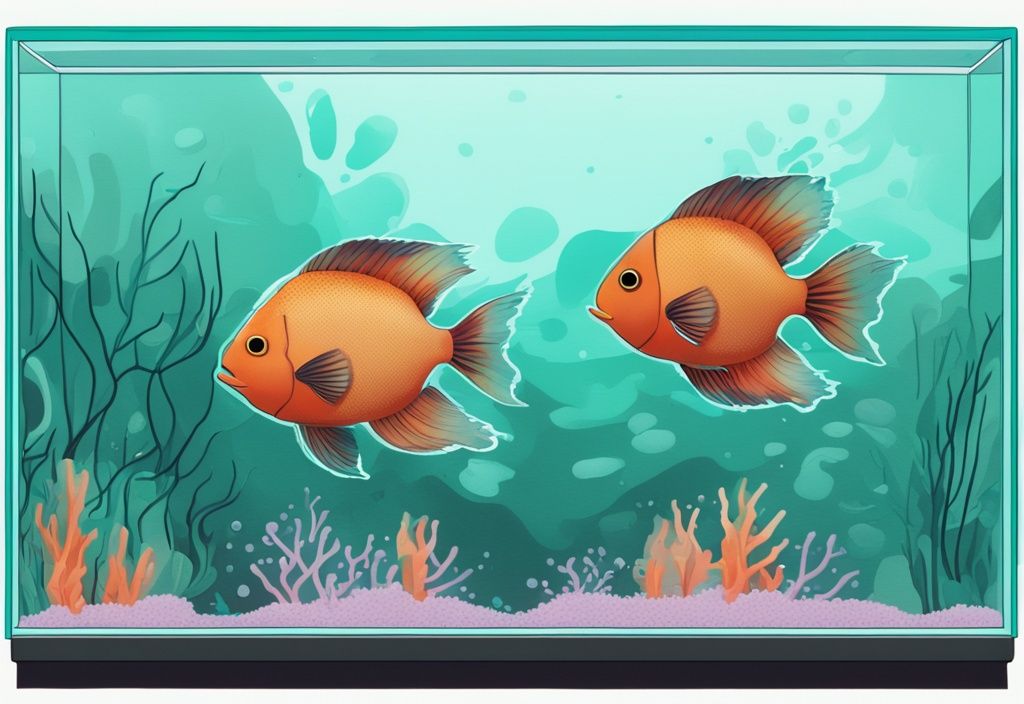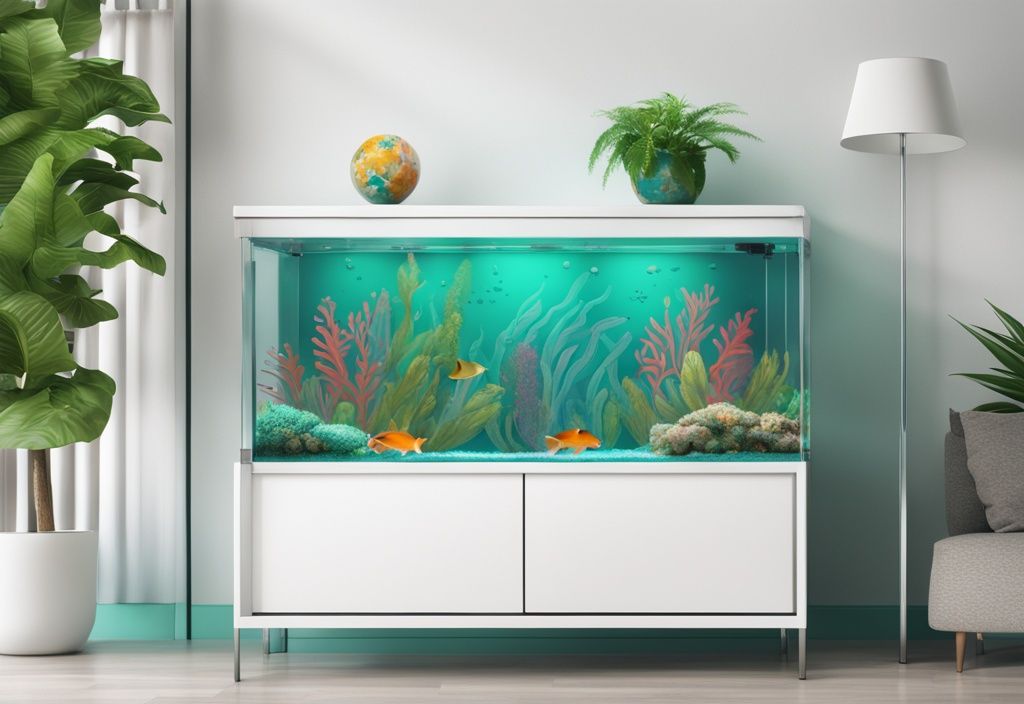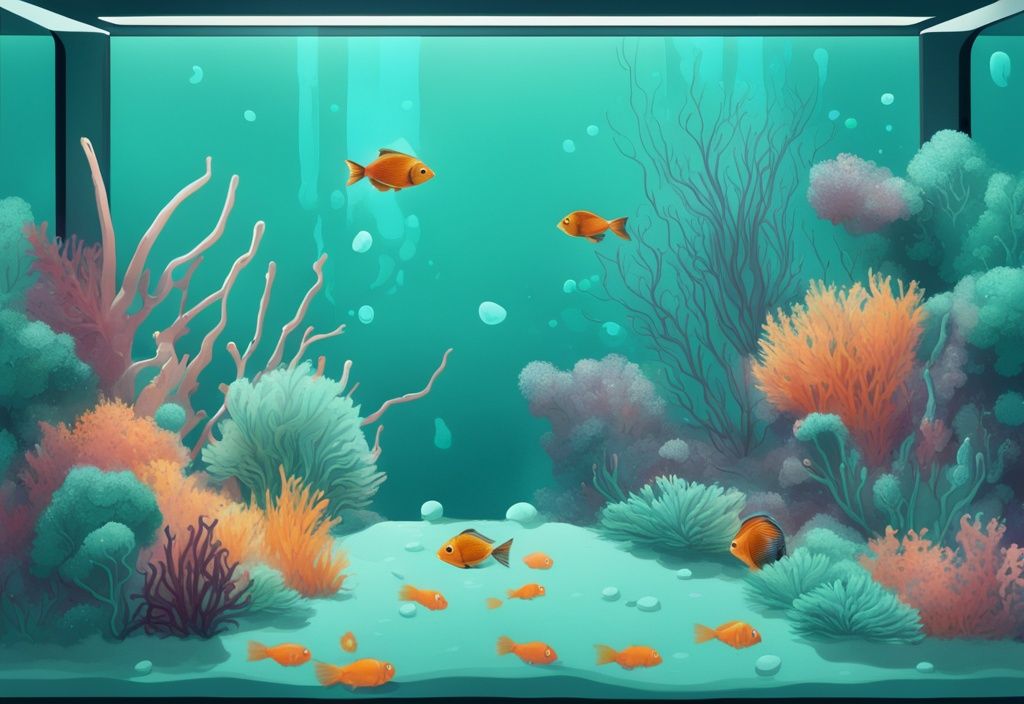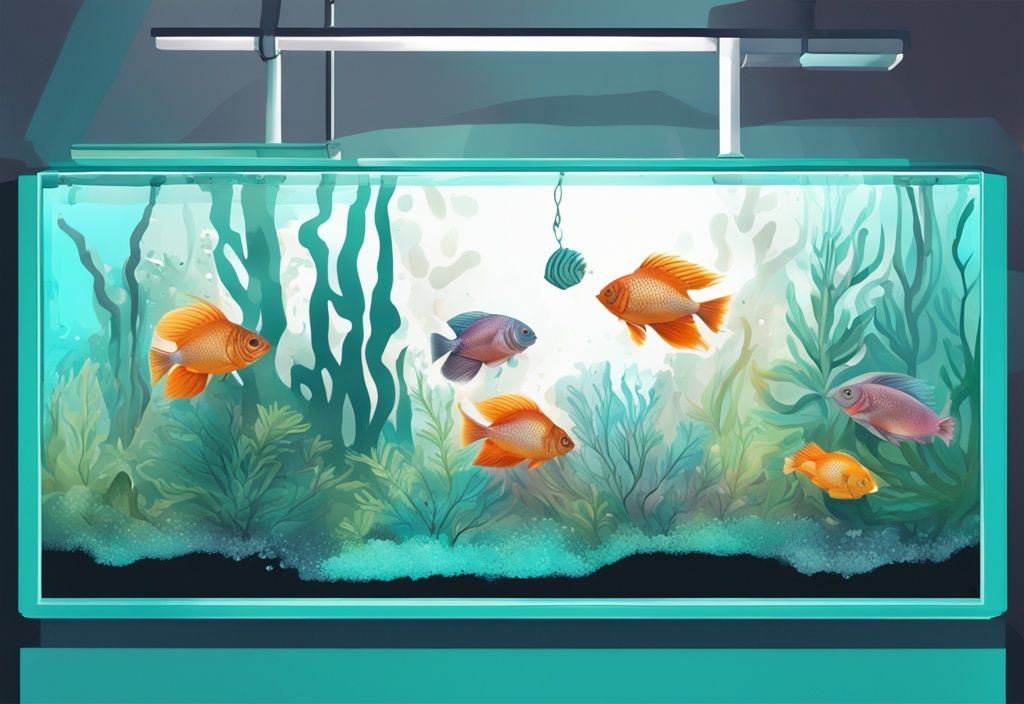Did you know that mysterious, slimy layer in your aquarium isn’t always a sign of bad hygiene? In fact, it’s called biofilm, and believe it or not, it plays a significant role in the ecosystem of your fish tank. At first glance, biofilm can be unsettling even to the most seasoned of fish tank owners.
In this guide, you’ll gain a comprehensive understanding of biofilm, deciphering its roles, and unraveling its complexities. We’ll navigate through the uncharted waters of why it forms, how it affects water quality, and ultimately impact fish health. Key strategies for management and control will be illuminated along the way.
Plunge into this engaging journey with me, and you can transform your apprehension into action. By the end of this guide, you’ll be well-equipped to maintain both the balance and beauty of your underwater world.
Understanding What is Biofilm in Fish Tanks
Defining Biofilm for Aquarists
Biofilm in a fish tank is a slimy layer composed of microorganisms that can form on any surface immersed in water. Though often viewed as undesirable, it is a natural phenomenon. Essentially, biofilm resembles a thin, slimy film of bacteria adhering to various surfaces.
Common examples outside aquariums include dental plaque and the slime observed on water surfaces. Biofilm in fish tanks is formed by a community of microorganisms, including bacteria, fungi, algae, and protozoa, creating a uniquely complex ecosystem within aquatic environments.
How Does Biofilm Form in Your Aquarium?
The formation of biofilm in a fish tank begins when bacteria adhere to surfaces within the watery environment and excrete a slimy substance comprised of polysaccharides and other materials. Surfaces such as leaves, seed pods, and driftwood provide ample opportunities for biofilm to develop.
The initial bacteria produce a matrix of sugars, facilitating the adhesion and multiplication of other bacteria. Feeding on excess organic waste, these bacteria contribute significantly to the formation of the film on the water’s surface.
Newly added botanicals often trigger biofilm production due to the organic materials they release. The process is a natural indicator that bacteria and microorganisms are actively breaking down organic matter, mirroring occurrences in natural aquatic habitats.
Positive and Negative Effects of Biofilm in Aquariums
The presence of biofilm in fish tanks introduces a dynamic layer of both benefits and challenges. This section explores the double-edged nature of biofilm, detailing its contributions to the aquatic ecosystem while highlighting potential issues that need to be managed.
Benefits of Biofilm to Your Aquatic Ecosystem
Role in Nitrogen Cycle
Biofilm in fish tanks plays a crucial role in the nitrogen cycle, an essential process for maintaining water quality. Within this biofilm, beneficial bacteria convert harmful ammonia—stemming from fish waste and decomposing organic matter—into nitrite, and eventually, into less toxic nitrate.
This transformation is critical for preventing ammonia buildup, which can be lethal for aquarium inhabitants.
As biofilm diligently breaks down waste products, it fosters a healthier aquatic environment by ensuring toxic substances are kept at bay. By facilitating these conversions, biofilm helps maintain a stable and balanced ecosystem within the tank.
Source of Beneficial Bacteria
Another key benefit of biofilm in fish tanks is its role as a habitat for beneficial bacteria essential for biological filtration. These bacteria are integral to the tank’s ecological balance, playing a pivotal part in decomposing organic material and neutralizing harmful substances. This ensures that the water remains safe and conducive for the fish and other aquatic life.
Supplementary Diet for Shrimp and Fish
Biofilm also serves as a natural food source for certain aquatic species, particularly shrimp and some fish. Enriched with nutrients like sterols, fatty acids, amino acids, and vitamins, biofilm supports the growth and health of these animals.
In shrimp tanks, biofilm can be intentionally cultivated by adding powdered food, leaves, wood, and blanched vegetables. This encourages biofilm growth, providing a steady supplementary diet that enhances the well-being of shrimp and fish.

Potential Downsides of Biofilm
How Overgrowth Impacts Water Quality?
Despite its benefits, biofilm overgrowth can detrimentally affect water quality in a fish tank. Excessive biofilm can deplete oxygen levels, obstruct CO2 release, and potentially lead to asphyxiation in fish, shrimp, and beneficial bacteria. This oxygen depletion usually signals an environmental imbalance in the tank, deteriorating overall water quality and reducing the habitat’s hospitality for aquatic life.
Managing Biofilm for Tank Aesthetics
Biofilm overgrowth can also impact the visual appeal of your aquarium. Overgrown biofilm tends to cover tank decorations, plants, and viewing areas, leaving a slimy layer that detracts from the tank’s aesthetic charm.
Regular maintenance, such as scrubbing and rinsing surfaces or using surface skimmers, is crucial to keep the tank looking clean and visually pleasing. By keeping biofilm levels controllable through consistent care, the tank’s display remains pristine and delightful to observe.
Preventing Biofilm from Harming Fish and Equipment
Biofilm overgrowth can disrupt the functionality of tank equipment, clogging filters and other devices, thus reducing their efficiency and potentially leading to malfunctions. Moreover, biofilm may harbor pathogens harmful to fish, increasing the risk of disease outbreaks.
To mitigate these risks, consider implementing measures such as using surface skimmers, maintaining adequate water flow, and introducing biofilm-eating species like snails and shrimp. These preventive strategies help ensure that biofilm doesn’t negatively impact fish health or tank equipment functionality.
Role of Tank Management in Controlling Biofilm
Biofilm in a fish tank can quickly turn a thriving aquatic environment into a problematic one. Understanding how to manage your tank effectively is key to keeping biofilm at bay. Let’s delve into the intricate aspects of tank management that play crucial roles in controlling biofilm formation.
Does Organic Waste Cause Biofilm Build-Up?
Biofilm in fish tanks thrives on organic waste such as uneaten food, fish feces, decaying plant matter, and leaching substrates. Eliminating every bit of organic waste is virtually impossible without removing all fish and plants. Nonetheless, reducing waste is crucial for managing biofilm formation. Regular cleaning routines, including siphoning debris from the substrate and performing partial water changes, are essential for minimizing waste.
Efficient filtration systems are invaluable. Filters with mechanical, chemical, and biological components play a significant role in removing waste before it can contribute to biofilm growth. Think of your filter as the lifeline of your tank, diligently working to keep the environment clean and balanced.
Effect of Overfeeding and Excess Light on Biofilm
Overfeeding your fish is one of the easiest ways to inadvertently promote biofilm growth. Uneaten food decomposes quickly, providing a nutrient-rich buffet for the microorganisms that form biofilms. Regulating feeding times and portions can prevent excess food from decaying and contributing to biofilm. High levels of light can also facilitate the growth of algae-based biofilms, which thrive on illumination. To maintain a healthy aquarium environment, it’s important to understand what kind of water for a fish tank is best. Imagine your tank as a mini ecosystem where balance is key. Controlling the amount of light your tank receives, whether by reducing the duration of light exposure or using less intense lighting, can help curb the development of light-dependent biofilms.
Why Excessive Fertilizer Leads to More Biofilm?
Using fertilizers, especially those containing iron, can stimulate the growth of iron bacteria, a common component of biofilm. Fertilizers are essential for plant health, but over-fertilization can tip the balance, encouraging unwanted biofilm growth.
Adjusting both the type and dosage of fertilizers is crucial for preventing biofilm-related issues. Regular monitoring of nutrient levels ensures they stay within optimal ranges for plant growth without promoting biofilm proliferation. Avoiding excessive doses of fertilizers, particularly iron-rich ones, will help manage biofilm growth effectively.
How to Identify Different Types of Biofilm
Understanding the types of biofilm in your fish tank is crucial for its maintenance. Each biofilm has unique characteristics and implications for the ecosystem within your aquarium.
Recognizing Bacteria-Based Biofilms
Bacteria-based biofilms in fish tanks often appear as a white or grayish sludge clinging to surfaces such as rocks, glass, and filter components. These films are composed of various bacterial colonies, significantly contributing to the tank’s waste processing system. Despite their somewhat unappealing appearance, they typically don’t emit a strong odor.
Unlike other more odorous biofilms, these bacterial communities play a vital role in breaking down organic waste. This process is essential for maintaining ecological balance and supporting the nitrogen cycle, contributing significantly to the biofilm in the fish tank. Occasionally, you might find this necessary gunk on your stones or filters, quietly doing its job to keep your underwater world in harmony.
Distinguishing Algae-Based Biofilms
Algae-based biofilms are notably different, easily identifiable by their green, slimy texture that clings to glass surfaces, decorations, and aquatic plants. These biofilms thrive under high light conditions due to their photosynthetic nature. When exposed to ample light, algae within the biofilm can spread rapidly, covering vast areas of the tank if not managed properly.
Regular maintenance is essential to keep these biofilms in check. This includes scrubbing affected surfaces and controlling light exposure, both crucial steps to prevent algae from overwhelming the aesthetic and health conditions of the fish tank. The presence of algae-based biofilms often indicates nutrient imbalances. Therefore, it’s vital to monitor and adjust feeding and fertilization practices accordingly.
In essence, understanding these biofilm distinctions helps you better care for your aquatic environment, ensuring a healthy, balanced ecosystem. With regular observation and maintenance, you can manage both types of biofilm effectively, maintaining the visual appeal and health of your fish tank.

Effective Strategies for Managing Biofilm in Fish Tanks
Managing biofilm in fish tanks can feel like an uphill battle, but armed with the right techniques, creating a balanced and thriving aquatic environment is entirely achievable. This section delves into DIY techniques, biological controls, and the occasional need for mechanical and chemical interventions to manage biofilm effectively.
DIY Techniques for Removing Biofilm
When tackling the persistent issue of biofilm in fish tanks, DIY methods offer practical and cost-effective solutions.
One effective technique involves using an airstone or surface skimmer to agitate the water surface, thus preventing biofilm from forming a stable layer. These devices keep the water moving, making it difficult for microorganisms to settle and form a biofilm.
For manual removal, consider using a scraper or soft brush to clean affected surfaces. This approach allows you to target specific areas where biofilm is visibly accumulating, such as on tank walls, decorations, and plants. Be sure to clean these tools thoroughly between uses to avoid spreading biofilm to other parts of the tank.
Another simple yet effective method involves using paper towels to absorb surface film. Lay a paper towel on the water’s surface to capture the biofilm; once absorbed, remove and discard the towel. This can be an excellent quick fix, especially for last-minute cleanups before showcasing your aquarium.
Biological Control Methods for Biofilm
Leveraging biological control methods can be highly effective in managing biofilm in fish tanks. Introducing biofilm-eating species like snails, shrimp, and Ottocinclus fish can naturally keep biofilm levels in check. These creatures not only feed on the biofilm but also contribute to a balanced and diverse aquarium ecosystem. To ensure optimal conditions for these species, it’s important to understand how to maintain the water parameters, including learning how to raise alkalinity in a fish tank.
Another approach involves the use of beneficial bacteria products. These products work by competing with harmful microorganisms for resources, thereby preventing the excessive growth of biofilm. Regularly adding these products to your tank can create a healthier environment, reducing the need for frequent manual cleaning and making the overall management of biofilm more straightforward.
Is Mechanical and Chemical Intervention Necessary for Biofilm?
In some cases, mechanical and chemical interventions may be necessary to control biofilm in fish tanks. Precision and caution are crucial in these approaches.
Mechanical measures like UV sterilizers can be particularly effective in reducing persistent biofilm. These devices work by killing microorganisms as water passes through them, thereby preventing biofilm formation. Additionally, filter modifications such as adding foam or sponge filters can help by trapping microorganisms before they adhere to surfaces within the tank.
Chemical treatments, like using hydrogen peroxide, can also be effective but should be used cautiously. Hydrogen peroxide can disrupt biofilm growth but may also harm other tank inhabitants if not applied correctly. Therefore, it’s essential to follow dosage recommendations and monitor tank conditions closely after treatment.
Repeated treatments with beneficial bacteria can offer a long-term solution for combating biofilm without the potential risks associated with chemical treatments. By consistently introducing beneficial bacteria, you can outcompete harmful organisms, promoting a more stable and healthy aquarium environment. Adopting a balanced approach that combines biological, mechanical, and occasional chemical interventions will ensure effective biofilm management in your fish tank.
Tweaking Your Management Strategy for Different Tanks
Managing biofilm in fish tanks can be intricate, as each type of tank—planted, freshwater, and saltwater—comes with its own unique set of challenges and requirements. Here’s a closer look at how to manage biofilm in different aquarium environments, ensuring a healthy and vibrant underwater world.
Special Considerations for Planted Tanks
Managing biofilm in fish tanks, especially planted ones, requires a nuanced approach because of the prevalence of organic materials that promote biofilm formation. In a planted aquarium, the decomposition of plant matter, excess nutrients, and prolonged light exposure create ideal conditions for biofilm growth.
To mitigate this, focus on regulating both light and nutrient levels. This can involve using timers to control the duration and intensity of lighting and regularly testing water parameters to avoid nutrient imbalances.
A certain level of biofilm is actually beneficial. It mimics a natural ecosystem and contributes to the biological filtration process. Instead of striving for a completely biofilm-free tank, aim for a balanced environment where biofilm is kept at manageable levels. Consistent maintenance and water care practices can significantly reduce the frequency of intensive cleaning, ensuring the health and vibrancy of the planted tank.
Freshwater vs Saltwater Tanks: Does Biofilm Management Change?
While the fundamental principles of managing biofilm in fish tanks apply to both freshwater and saltwater environments, there are unique considerations for each.
In freshwater tanks, biofilm management often focuses on maintaining appropriate water flow and minimizing excess organic waste from overfeeding or decaying plant material. Using surface skimmers can effectively reduce biofilm formation by keeping the water surface clean and promoting adequate oxygen exchange.
In saltwater tanks, the salt concentration can influence the types of microorganisms that make up the biofilm. This environment might require more specialized equipment like protein skimmers that remove organic compounds before they contribute to biofilm growth. Furthermore, choosing organisms such as certain algae-eating fish and invertebrates can help maintain biofilm at manageable levels.
Both tank types benefit from high water flow, which prevents the accumulation of biofilm on surfaces and ensures that organic particles remain suspended until they can be removed by filtration systems. Regular monitoring and maintenance tailored to the specific needs of each environment will promote a balanced and healthy tank.

Conclusion: Achieving a Healthy Balance with Biofilm in Your Tank
Biofilm in fish tanks is a natural component of any aquatic ecosystem, playing essential roles in biological filtration and the nitrogen cycle. Though often perceived as a nuisance, biofilm forms an integral part of maintaining ecological balance within the aquarium environment.
Understanding the formation and dynamics of biofilm is critical for effective tank management. Biofilm develops through the adherence of microorganisms to submerged surfaces, leading to a complex community of bacteria, algae, fungi, and protozoa. Recognizing the benefits these microorganisms offer—such as participation in the nitrogen cycle and providing food for certain fish and shrimp—can help aquarists appreciate the biofilm’s positive contributions.
Maintaining a healthy and visually appealing aquarium requires a multifaceted approach to managing biofilm. Ensuring proper tank management practices, such as regular cleaning routines, efficient filtration systems, and balanced feeding schedules, addresses the core of biofilm control. Additionally, employing biological controls, including the introduction of biofilm-grazing species like snails and shrimp, can sustainably manage biofilm levels without compromising the overall tank ecosystem.
Sometimes, mechanical or chemical interventions might be necessary, particularly when biofilm overgrowth becomes problematic. UV sterilizers, surface skimmers, or carefully monitored chemical treatments can effectively mitigate biofilm issues. However, these should be used sparingly to prevent negative impacts on other tank inhabitants.
Ultimately, achieving a balanced and healthy aquarium involves accepting biofilm as a natural part of the ecosystem while employing strategic measures to control its growth. This holistic approach ensures a thriving aquatic environment that is both ecologically sound and aesthetically pleasing.
FAQs: Your Key Biofilm Queries Answered
What Precisely is Biofilm in a Fish Tank?
Biofilm in a fish tank is a fascinating yet slimy layer comprising microorganisms like bacteria, fungi, algae, and other tiny organisms. It forms on submerged surfaces and is a vital part of the aquarium’s ecological processes. Think of it as a bustling, underwater community working behind the scenes to keep your tank’s environment balanced.
When Does Biofilm Become Harmful to My Fish?
Biofilm can turn from friend to foe when it grows out of control. An overgrown biofilm hogs oxygen, harbors harmful pathogens, blocks vital light, and clogs equipment. This imbalance disrupts the delicate ecological harmony of your tank, ultimately affecting the health of your fish.
Top Tips to Prevent Biofilm Build-Up in My Aquarium
Keeping biofilm in check is easier with proactive measures:
- Regular water changes
- Ensure robust filtration
- Avoid overfeeding your fish
- Control light exposure
- Use surface skimmers
- Maintain adequate water flow
By following these tips, you’ll minimize organic waste and manage biofilm growth effectively.
Can I Harness Any Benefits to Having Biofilm in My Tank?
Absolutely! Biofilm isn’t all bad. It enhances biological filtration and is a key player in the nitrogen cycle. Plus, it provides a natural food source for shrimp and certain fish, fostering a balanced and healthy aquatic ecosystem.
What Aquatic Creatures Can Help Control Biofilm?
Certain aquatic creatures can be your allies in biofilm management. Creatures like snails, shrimp, and Ottocinclus fish actively consume biofilm, keeping its levels in check while adding to your tank’s biodiversity. It’s nature’s clean-up crew at its best!
